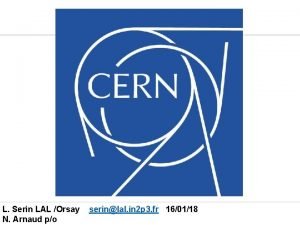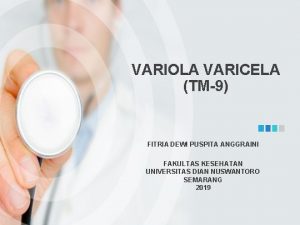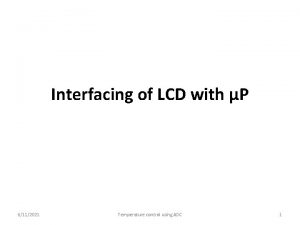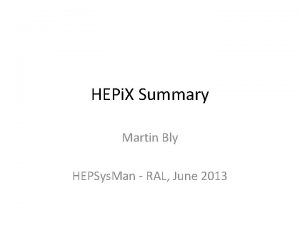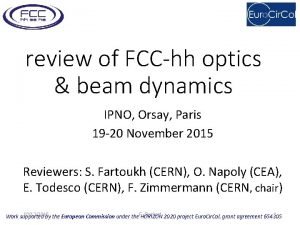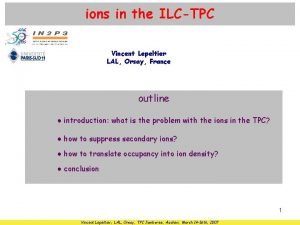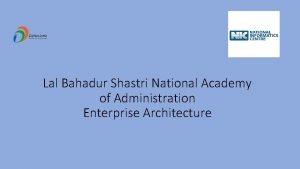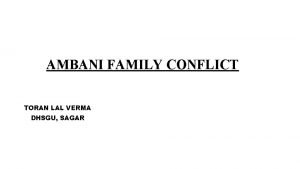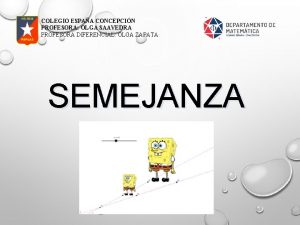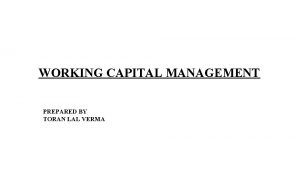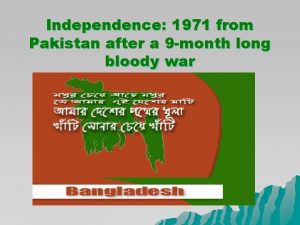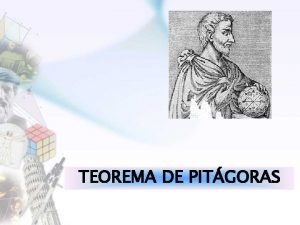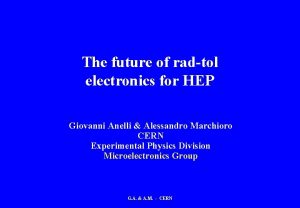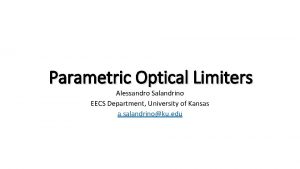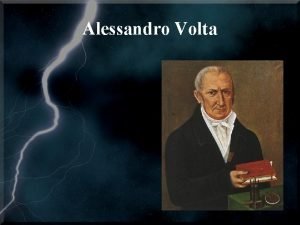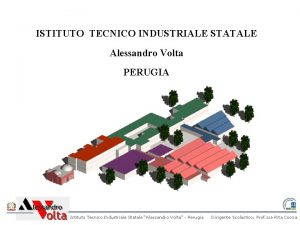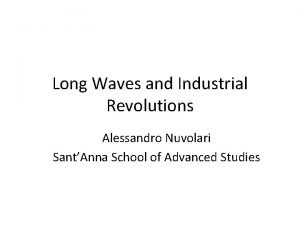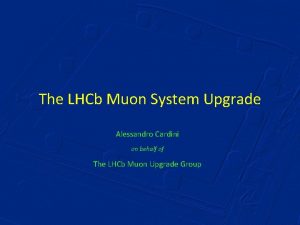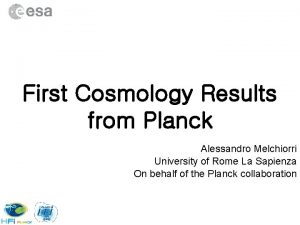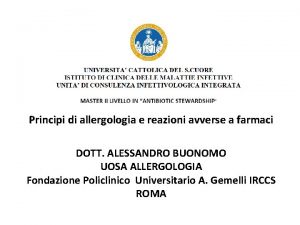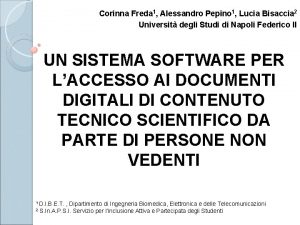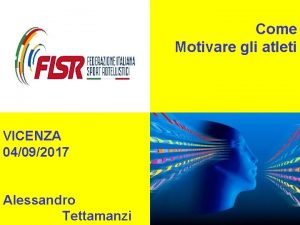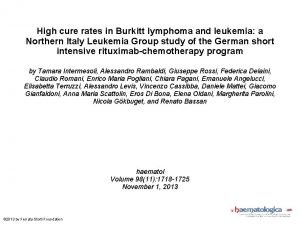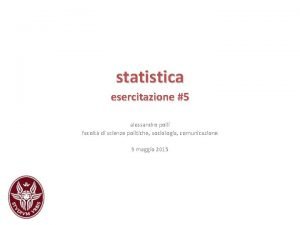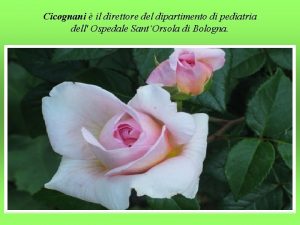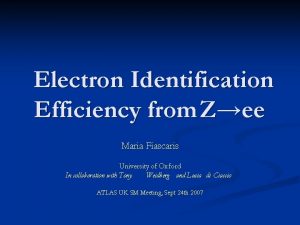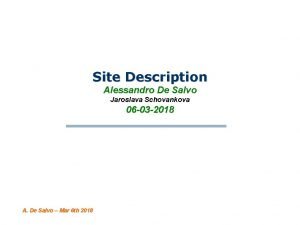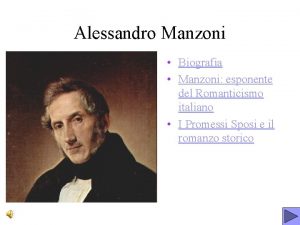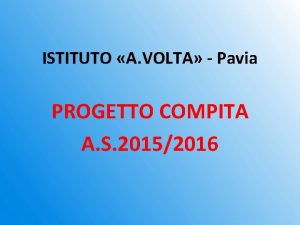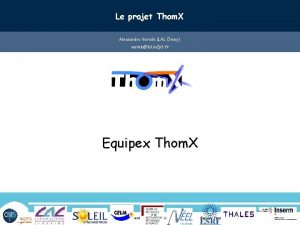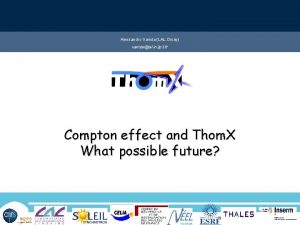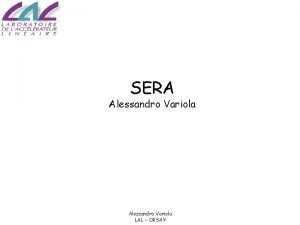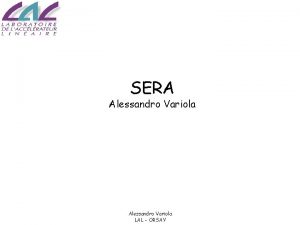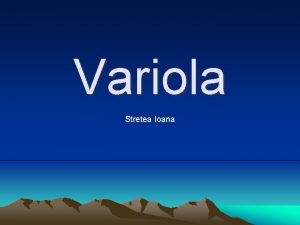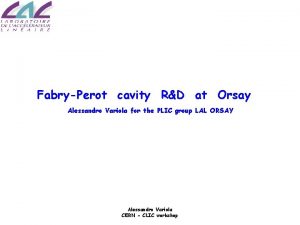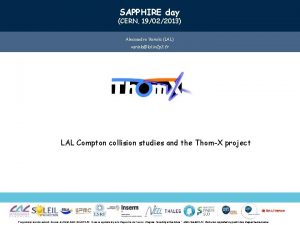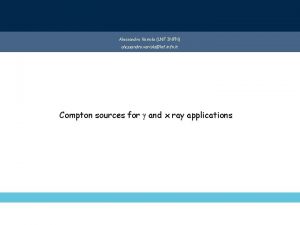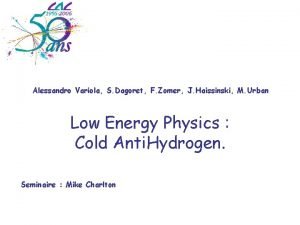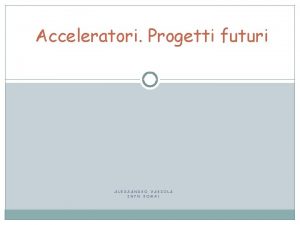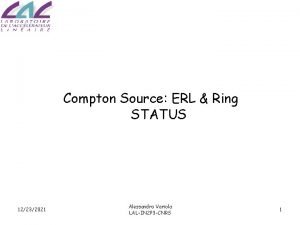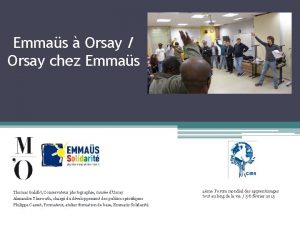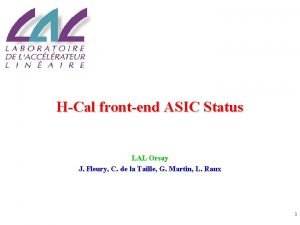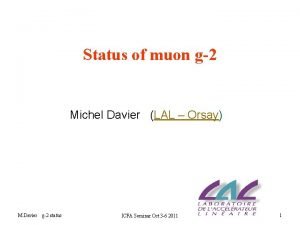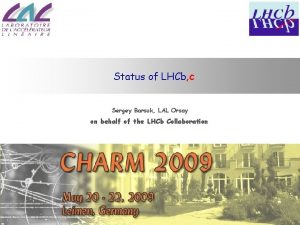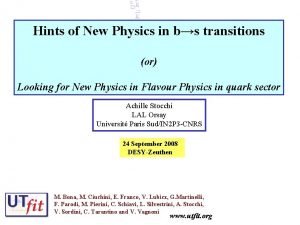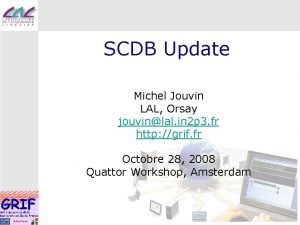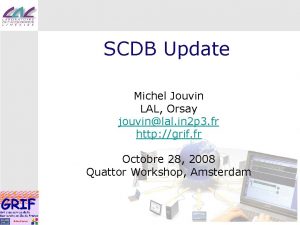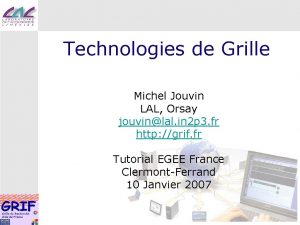P 2 I Alessandro Variola LAL Orsay 6112021



































- Slides: 35

P 2 I Alessandro Variola LAL Orsay 6/11/2021 Alessandro Variola, LAL ORSAY 1

- Source de positron polarisé et non polarisé pour les futurs collisionneurs - Upgrade des Lignes de mesure RF et du Faisceau dans l'infrastructure PHIL 6/11/2021 Alessandro Variola, LAL ORSAY 2

Cher Collègue, Suite à la sélection de votre proposition pour l'attribution d'un contrat post doctoral sur le sujet « Source de positron polarisé et non polarisé pour les futurs collisionneurs linéaires» par P 2 I, nous avons le plaisir de vous annoncer que votre dossier a été retenu par le Conseil de groupement pour un financement en 2009. Vous pouvez donc dès à présent lancer un appel d'offre pour ce contrat post doctoral de la manière la plus appropriée pour votre sujet de façon à pouvoir toucher les meilleurs candidats à des post docs commençant au début de l'année universitaire 2009 -2010 (le financement étant normalement prévu pour débuter à cette date). Un financement de 94 K sur 2 ans vous sera transféré quelques semaines avant le début du contrat. Cher Collègue, Suite à la sélection de votre proposition pour l'attribution d'une bourse R&D sur le sujet "Upgrade des Lignes de mesure RF et du Faisceau dans l'infrastructure PHIL" par P 2 I, nous avons le plaisir de vous annoncer que votre dossier a été retenu par le Conseil de groupement P 2 I pour un financement à hauteur de 30 K pour l'instant sur 2 ans. . 6/11/2021 Alessandro Variola, LAL ORSAY 3

• Sources de Positrons • CLIC-ILC, Hybrid Source • Super. B, HOM capture • Both solutions are ‘Baseline’ 6/11/2021 Alessandro Variola, LAL ORSAY 4

POSITRON SOURCES USING CHANNELING FOR ILC & CLIC • INTRODUCTION • • * Necessity to consider conventional-like sources * Good results and perspectives for crystal sources using electron channeling in axially oriented * Studies on energy deposition in crystal and amorphous targets confirm the interest of crystals for the total energy deposited which is less than in an amorphous targets giving the same yield. * Simulations and experiments showed that an hybrid scheme (crystal radiator + amorphous converter) is advantageous. Such a solution allows a limited energy deposition in the crystal. 6/11/2021 Alessandro Variola, LAL ORSAY 5

POSITRON SOURCES USING CHANNELING FOR ILC & CLIC • THE PROBLEM OF PEDD • The local and almost instantaneous energy deposition in a target (for instance during a pulse duration) may be very critical for the target survival. Indeed, due to inhomogeneous energy deposition in the target, thermal gradients causing mechanical stresses lead to target destruction as by shock waves. After the SLC target destruction, analyses showed that a maximum value of 35 J/g (in tungsten) must not be exceeded. The PEDD is strongly depending on the incident beam intensity and energy and on its transverse dimensions; it depends also on the thickness of the target. 6/11/2021 Alessandro Variola, LAL ORSAY 6

POSITRON SOURCES USING CHANNELING FOR ILC & CLIC • THE BASIC SCHEME FOR ILC & CLIC “x” meters e+ e- e + , e -, g Crystal Radiator g e. Amorphous Converter Only the photons are impinging on the converter: that limits the energy deposition in the amorphous target. The yield is less than if the particles coming from the crystal were also impinging on the amorphous target 6/11/2021 Alessandro Variola, LAL ORSAY 7

POSITRON SOURCES USING CHANNELING FOR ILC & CLIC • • • * THE CRYSTAL : Photons generated by electrons in channeling conditions and above barrier. * The crystal, axially oriented, may be W, Si, Ge, C(d)… In our case, we choose W in <111> orientation * THE AMORPHOUS CONVERTER: it is made of W * THE DISTANCE RADIATOR-CONVERTER: it is of some meters; here it is 2 meters. It allows the use of sweeping magnet in between. Another possibility is to select also charged particles coming from the radiator (e+, e-) with energy larger than Etreshold to increase the yield e+/e- * IMPINGING ENERGIES: E- = 3, 4, 5 and 10 Ge. V • SIMULATIONS • • Incident beam: electron beam energy between 3 and 10 Ge. V and transverse rms radius of 1 and 2. 5 mm have been considered Targets: (a) Crystals of 1, 2 and 4 mm thick: for E-=10 Ge. V Amorphous target of 8 mm (b) Crystals of 1. 4, 2. 4 et 4. 4 mm thick for E- =3, 4 and 5 Ge. V Amorphous target of 10 mm thick Capture system: an Adiabatic Matching Device with a magnetic field decreasing from 6 Teslas to 0. 5 Teslas on 50 cms. Iris aperture is ~20 mm radius. Accelerating field is 18 Me. V/m peak value [SW] Outputs: Simulations have been carried out corresponding to the general scheme. The yield e+/e-, the transverse emittance as the longitudinal emittance have been determined at the end of the solenoid (270 Me. V). The capture efficiency has also been determined. 6/11/2021 Alessandro Variola, LAL ORSAY 8

POSITRON SOURCES USING CHANNELING FOR ILC & CLIC TABLE OF SIMULATION RESULTS FOR DIFFERENT ELECTRON ENERGIES 6/11/2021 Alessandro Variola, LAL ORSAY 9

Hybrid Amorphous, CLIC-ILC • • • INCIDENT BEAM: an incident electron beam of 10 Ge. V TARGETS: CRYSTAL: a 1 mm thick W crystal <111> orientation AMORPHOUS: a 8 mm thick amorphous target CAPTURE SYSTEM: AMD with decreasing field from 6 to 0. 5 Tesla on 50 cms Accelerating field is 18 Me. V/m, peak [SW] • • RESULTS: accepted yield: 1. 8 e+/e- (s -=1 mm) 1. 5 e+/e- (s -= 2. 5 mm) • PEDD: assuming an incident e- bunch of 2. 1010 e- • • • . crystal PEDD/e. PEDD/bunch s - =1 mm 2 Ge. V/cm 3 0. 33 J/g/bunch s - =2. 5 mm 0. 35 Ge. V/cm 3 0. 058 J/g/bunch amorphous PEDD/e. PEDD/bunch 7. 5 Ge. V/cm 3 1. 25 J/g/bunch 2 Ge. V/cm 3 0. 33 J/g/bunch It is quite clear that the hybrid target cannot sustain the 2820 bunches and that distributed targets system must be considered. For Clic (less bunches… 312) it is feasible 6/11/2021 Alessandro Variola, LAL ORSAY 10

POSITRON SOURCES USING CHANNELING FOR ILC & CLIC • • LONGITUDINAL EMITTANCE AT END OF CLIC PREACCELERATOR [s -=1 mm] Blue: 80% Red: rms ez =9. 5 pcm. Me. V For s -=2. 5 mm, the emittance shape is very similar and the rms area almost the same 6/11/2021 Alessandro Variola, LAL ORSAY 11

POSITRON SOURCES USING CHANNELING FOR ILC & CLIC • PROPOSED POSITRON TARGET FOR CLIC 2 m e+ e(5 Ge. V) e + , e -, g Crystal W: 1. 4 mm thick g e. Amorphous W: 10 mm thick With an incident beam of 2. 34 10 12 e-/pulse, we expect 2. 1 10 12 e+/pulse at 270 Me. V (pulse of 156 ns) Or 6. 7 109 e+/bunch 6/11/2021 Alessandro Variola, LAL ORSAY 12

Primary Electron Beam Linac beam Thermioni Bunching Primary electron Linac c system e- gun e-/g Target g/e+ Target 5 Ge. V Parameter for 3 Te. V Crystal Unit CLIC Primary e- Beam Energy Ge. V 5 N e- /bunch 109 7. 5 - 312 N e- / pulse 1012 2. 34 Pulse length ns 156 Repetition frequency Hz 50 Beam power k. W 94 Beam radius (rms) mm 2. 5 Bunch length (rms) mm 0. 3 N bunches / pulse Amorphou s Electron beam parameters on the crystal target October 2009 With an yield of 1 e+/e- (at 200 Me. V) , the charge is 7. 5 x 109 e-/bunch on the target. Parameters used for BINP/CERN/IPNL/LAL simulations

PEDD study for CLIC targets Thickness amorphous target Today choice Distance crystal amorphous target e+/e- Power deposited in amorphous target GEANT 4 simulations CLIC Note 808

POSITRON SOURCES USING CHANNELING FOR ILC & CLIC • PROPOSED SCHEME FOR ILC: ONLY IF MULTITARGET • A thesis is ongoing!!! 2 meters e+ e- e + , e -, g Crystal multitarget g e. Amorphous multitarget With incident beam of 2. 1010 e-/bunch the expected accepted e+ yield is of 3. 7 10 10 e+/bunch at 270 Me. V (s =1 mm). It is of 3. 1010 e+/bunch for s -=2. 5 mm 6/11/2021 Alessandro Variola, LAL ORSAY - 15

POSITRON SOURCES USING CHANNELING FOR ILC & CLIC • • • SUMMARY AND DISCUSSION * Hybrid schemes using a crystal as a radiator and an amorphous target where only g coming from the crystal are sent, have been studied for CLIC and ILC as “conventional” solutions. The simulation results showed accepted yields in accordance with the requirements. The emittances at the end of the preaccelerator (270 Me. V) can be improved through optimization of the capture section and bunch compression in the longitudinal phase space; energy compression can also been considered in view of efficient stacking in the damping ring. * One of the main concerns for positron targets is the energy deposited. As demonstrated in recent papers, the total energy deposited is less for a purely cristalline target than for the equivalent (giving the same yield) amorphous target. The Peak Energy Deposition Density (PEDD) is comparable. But using hybrid targets with a separation between the crystal and amorphous parts giving the possibillity of sweeping off part or all the charged particles, allows lowering of the PEDD and henceforth, avoiding multi-target use. That solution can be worked out with CLIC. Concerning ILC, the very intense pulse (> 1013 e-) precludes use of a unique hybrid target: both crystal and amorphous systems are multitargets; that makes the crystal solution hard to work out. 6/11/2021 Alessandro Variola, LAL ORSAY 16

• CLIC notes • Dynamics on the positron capture and accelerating sections of CLIC • The CLIC positron capture and accelertation in the injector LINAC • Study of an hybrid positron source using channeling for CLIC • 4 Conference proceeding between CLIC and Super. B 6/11/2021 Alessandro Variola, LAL ORSAY 17

Preger – Guiducci Scheme Diag line Energy, spread, beam size current “new” scheme Separator e+-e. Monitor Size and position En spread 0. 7 Ge. V 300 Me. V CAPTURE SECTION PC combiner DC dipole e+ BUNCH COMPRESSOR POLARIZED SLAC GUN SHB B graded S band Sections 50 Me. V 0. 2 Ge. V Diag lina Polarization, en spread Emittance bunch length SHB 0. 6 Ge. V (safety) monitor THERMIONIC GUN HE diag Emittance, , En spread Bunch length Emittance Moller polarimeter 4 Ge. V (straight line) 5. 7 Ge. V e+ 4. 0 Ge. V ee 250 Me. V matching Proposal for Vacuum regions HE diag Emittance, , En spread We propose to stay with the SLAC gun in the positron line and to have a custom Polarised, in the electron line 6/11/2021 low charge electron sources Alessandro Variola, LAL ORSAY 18

Positrons a) b) c) d) - (thanks to Freddy) 1) Target production and optimization 2) AMD vs QWT, Parmela, Geant 4 and Astra ok 3) Polarization studies (Geant 4) – not needed 4) Capture in 4 different scenarios : S band acceleration + S band deceleration + S band L band deceleration + L band TM 020 deceleration + L band 5) Transport (FODO design) up to 1 Ge. V in the 4 cases 6) Coupling studies 7) 1. 428 GHz cavity design 8) TM 020 cavity design : 4 cells will be prototyped in Aluminium 9) Comparison with Dafne source (~ok). Experiment soon? 6/11/2021 Alessandro Variola, LAL ORSAY 19

Realisations: Design Study of Travelling wave Section (1) Ø Design of RF structure (using Superfish) - 6/11/2021 Structure with 6 cylindrical cavities Using TM 020 -2 /3 Operating at 3 GHz Design Parameters: - Cell dimensions: Rcell ~ 9 cm Lcell ~ 3. 331 cm - Irises dimensions: Riris=1. 5 cm Liris= 0. 8 cm Ez along z-axis Alessandro Variola, LAL ORSAY E-field TM 020 -2 /3 P. Lepercq

Stress and thermal effects • PEDD • @200 Me. V Pedd 1. 7 10 -12 J/g/e- • @ 300 Me. V Pedd 2. 5 10 -12 J/g/e- • @ 500 Me. V Pedd 3. 3 10 -12 J/g/e- • 6. 6 e 10*5 = 3. 3 10 11 e- (10 nc 5 bunch) • So (max limit 35 J/g) • • • 200 Me. V on a PEDD= 0. 55 J/g 300 Me. V on 0. 85 J/g 500 Me. V 1 J/g • AVERAGE deposited energy: • @200 Me. V 52. 5 Me. V/e - / @ 300 Me. V 77. 6 Me. V/e - / @ 500 Me. V 120 Me. V/e - • Tungsten density 19. 25 g/cm 3 • So for the different cases in a cubic cm target we have to multiply for 25 (Hz) and ~20 (density) • So in the worst case (500 Me. V) we have 160 W (70 W@200 and 100 W @300). Not so hard to cool 6/11/2021 Alessandro Variola, LAL ORSAY O. Dadoun 21

The ACS • Accelerating / Deceleration • depending on the type of RF cavities within the ACS – – 6/11/2021 1 st scenario = 2. 846 GHz full acceleration 2 nd scenario = 2. 846 GHz deceleration + acceleration 3 rd scenario = 1. 428 GHz deceleration + acceleration 4 rd scenario = combination of RF types (using 3 GHz TM 020 mode for deceleration and 1. 428 GHz TM 010 for downstream acceleration). Alessandro Variola, LAL ORSAY 22

Recap • 4 Scenarios under investigation Scenario 1 2 3 4 RF (MHz) – strategy 2856 - acc 2856 – dec 1428 – dec (S-band) (L-band) 3000 dec + 1428 - acc Mean Energy (Me. V) 302 287 295 333 Erms (Me. V) 21. 4 32. 3 (12) 16. 83 (9. 09) 5. 2 (3. 2) Zrms (mm) 2. 7 6. 4 8. 89 3. 5 Xrms (mm) 3. 8 4. 4 8. 0 8. 1 X’rms (mrad) 1. 02 1. 11 1. 69 1. 4 Ex =X’X (mm. mrad) 3. 8 4. 6 13. 0 11. 4 Total Yield (%) 2. 8 7. 53 32. 3 31. 9 Yield ± 10 Me. V (%) 1. 3 3. 9 19. 6 29. 3 25 MV/m for acceleration With a positron injection of 10 n. C and a yield of 3. 9%, we will have 2. 43 109 positrons at 300 Me. V ± 10 Me. V (scenario 2 – 2. 8 GHz) 6/11/2021 Alessandro Variola, LAL ORSAY 23

End of 1 st Tank – 3000 MHz • Length of 1 st Scenario 4 tank = ~2. 93 m – Cell length= 3. 331 cm Gaussian Fit sz = 3. 66 10 -3 m Energy (Me. V) • Tank Phase f 1= 280 o • Tank Gradient G 1=10 MV/m Energy (Me. V) 6/11/2021 Alessandro Variola, LAL ORSAY Z (m) 24 Z (m)

Layout Example Up to ~1050 Me. V Acc. Cavity 1. 428 GHz, Peak gradient= 13 MV/m 3 GHz 10 MV/m Fodo cells 38 ~160 m Solenoid 0. 5 T 0. 5 34. 1 m 6/11/2021 Matching section 34. 3 ~38 m Alessandro Variola, LAL ORSAY 25

At end of the fodo accelerating 3. 0 GHz tank (deceleration), section ~1050 Me. V Yield (e+/e-) Energy (Me. V) At ~160 m, after the target. Z (m) 6/11/2021 F. Poirier At exit of last cavity, Particles within a cut radius: Total yield Yield ± 10 Me. V 1050 ± 10 Me. V Radius (m) 240 p. C Alessandro Variola, LAL ORSAY 26

PHIL - Photoinjecteur au LAL 6/11/2021 Alessandro Variola, LAL ORSAY 27

Transport • • • Diagnostics Charge : Faraday cup, ICT Énergie : dipole + slit, YAG screen Size: YAG-Ce screen + CCD Position : 2 BPM Bunch length : Cerenkov + streak Emittance : 3 gradients (solenoid), pepper-pot (slits) 6/11/2021 Alessandro Variola, LAL ORSAY 28

Charge Transport HF Booster RF Gun screen Emittance BPM 2 BPM 1 Vacuum valve laser solenoids 6/11/2021 1 m pump Faraday cup slit Cerenkov 60° dipole Alessandro Variola, LAL ORSAY 29

Charge= f(phase) Max charge: 0. 2 n. C After dark current substraction 6/11/2021 Alessandro Variola, LAL ORSAY 30

Energy Transport HF 1 m Booster screen RF Gun Emittance BPM 2 BPM 1 Vacuum valve laser Faraday cup slit solenoids Cerenkov 6/11/2021 PUMP 60° dipole Alessandro Variola, LAL ORSAY 31

Energy • Dipole measurements • • Estimated energy: 5 Me. V +/- 0. 5 Me. V good agreement Energy meas. Slit • We can increase the resolution with the slit 6/11/2021 Alessandro Variola, LAL ORSAY 32

Beam size 6/11/2021 Alessandro Variola, LAL ORSAY 33

Beam Sizes Waist (best set) : 0. 5 mm 6/11/2021 Alessandro Variola, LAL ORSAY 34

Conclusions We found P 2 I a very effective financing source No red tapes, fast financing for average amounts Thanks to this a lot of work has been done We believe that it was a good success!!!! We propose and studied the baseline positron sources for CLIC and Super. B • As far as PHIL is concerned we realized a lot of measurements and we will improve the facility • Unfortunately: - Accepted for a request of 90 k Euros - Reduced to 30 k. Euros (but we had not a no program reduction plan…) - We did not receive any money, following our administration…are we wrong? • • • 6/11/2021 Alessandro Variola, LAL ORSAY 35
 Lal orsay
Lal orsay Varicela variola
Varicela variola 6112021
6112021 6112021
6112021 Old man ral
Old man ral Ipno orsay
Ipno orsay Orsay aachen
Orsay aachen Lbsnaa mess menu
Lbsnaa mess menu Dhsgu
Dhsgu Criterio lal
Criterio lal Www.mohanscience.lk
Www.mohanscience.lk Okir meghatalmazás
Okir meghatalmazás Toran lal verma
Toran lal verma Figuras congruentes
Figuras congruentes Lal bager kella
Lal bager kella Teorema de thales reloj de arena
Teorema de thales reloj de arena Alessandro marchioro
Alessandro marchioro Alessandro salandrino
Alessandro salandrino How did alessandro volta invent the battery
How did alessandro volta invent the battery Microcomedão
Microcomedão Itis volta perugia indirizzi
Itis volta perugia indirizzi Alessandro nuvolari
Alessandro nuvolari Alessandro cardini
Alessandro cardini Alessandro melchiorri
Alessandro melchiorri Dott. alessandro buonomo allergologo
Dott. alessandro buonomo allergologo Corinna martinella
Corinna martinella Alessandro tettamanzi
Alessandro tettamanzi Alessandro rambaldi
Alessandro rambaldi Alessandro polli
Alessandro polli Direttore pediatria sant'orsola
Direttore pediatria sant'orsola Alessandro fiascaris
Alessandro fiascaris Alessandro montessori
Alessandro montessori Alessandro de salvo
Alessandro de salvo Rosario d'alessandro
Rosario d'alessandro Biografia di alessandro manzoni
Biografia di alessandro manzoni Liceo artistico alessandro volta pavia
Liceo artistico alessandro volta pavia
